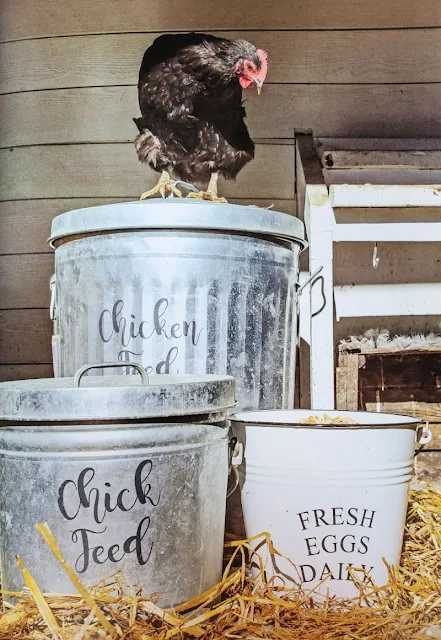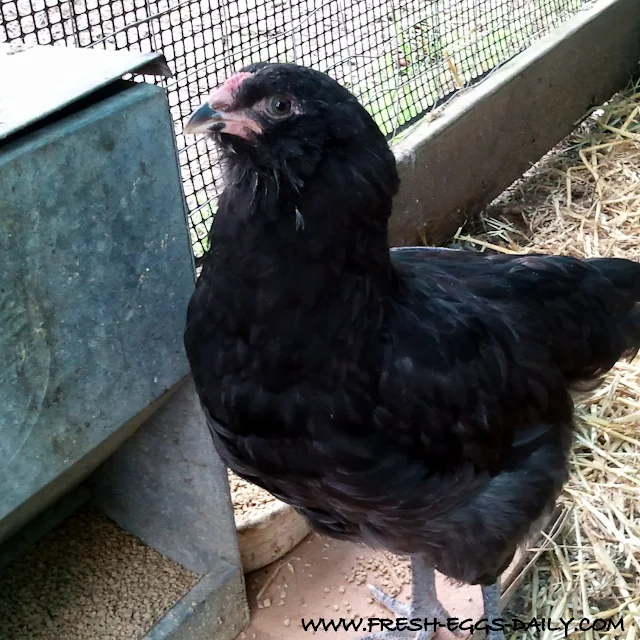Chicken Feed Guide | Chick to Laying Hen
Depending on where you buy your feed, you might get accurate information about what you should be feeding your chickens at various points in their life - or you might not.
It's very important to match the type of feed - i.e. chick, starter, grower or layer - to the age of the birds in your flock.
Should I Feed My Mixed Flock an All Flock or Flock Raiser Feed?
I remember being horrified early on, after having been told that a "flock raiser " feed was perfect for our growing mixed flock of chickens and ducks and bringing home a bag, only to find that it would have been perfect had we been planning on EATING our flock!
The feed store (correctly) recommended it for our mixed flock of chickens and ducks, but (incorrectly) recommended it to a mixed future LAYING flock.
With 22% protein, it would have put weight, on the ducklings especially, way too fast causing leg and foot issues and could also have caused them to start laying too soon.
I always recommend staying away from any feed that is supposedly perfect for any number of species because it's usually not great for any single one.
Most of the "all flock" or "flock raiser" feeds have way too much protein and not nearly enough calcium for your chickens and ducks, so be sure to read the labels to be sure you know exactly what you're buying.
Can I Feed Chicks Layer Feed?
I have also been told by the feed store that chicks can eat layer feed without a problem.
Again, incorrect.
The extra calcium in the layer feed can cause kidney problems in non-laying chicks and pullets, as well as weak legs or even death.
Confused and not trusting what I was being told by our local feed stores, I did my own research, called a few hatcheries and feed companies and now feed our chicks, pullets and laying hens, as well as our ducklings and ducks, what they specifically need for each stage of life.
Remember that this is an imprecise science, so I generally switch to new feed at or about the ages listed - or when I run out of my last bag of the current feed (you can even mix the tail-end of a bag into the new feed so as not to waste it).
Chicken Feed Guide | Chick to Laying Hen
So based on my own reading and research, plus more than a decade of raising any number of chicks, chickens, roosters, etc. here's a handy reference to the feed requirements for your chickens.
Chicken Feed Guide | Hatch to 8 Weeks
Feed: Chick Starter (18-20% protein)
Water: Room temperature with stones or marbles in it so chicks don't drown, with a splash of apple cider vinegar several times a week. Sugar water the first day, optional, for shipped chicks (1T sugar per quart of water)
Grit: Chick-sized grit or coarse dirt, if fed anything besides chick feed
Calcium: N/A
Supplements: Sprinkle of probiotic powder (thought to combat coccidia), sprinkle of brewer's yeast (especially important for ducklings) and garlic powder (immune system booster) over feed, sea kelp, assorted fresh chopped or dried culinary herbs, especially oregano, sage and parsley
Treats: Limited. I stick to moistened oats (helps with pasty butt), soft scrambled eggs, minced garlic, chopped weeds, herbs and clumps of grass.
Chicken Feed Guide | 8 Weeks to 14 Weeks
Feed: Starter/Grower Feed (16-18% protein)Water: Cool water with 1 Tablespoon of apple cider vinegar per gallon twice a week
Grit: Commercial grit or coarse dirt/small stones
Calcium: N/A
Supplements: Sprinkle of probiotic powder, brewer's yeast and garlic powder, and DE (food-grade diatomaceous earth) added to feed if the pullets are spending time outside, sea kelp, dried culinary herbal blend
Treats:
Begin to introduce other healthy treats in moderation: vegetables such as cucumbers, tomatoes, leafy greens, watermelon, corn or peas, whole grain pasta or brown rice, along with the moistened oats, soft scrambled eggs, minced garlic, cut weeds and clumps of grass.
Chicken Feed Guide | 15 Weeks to 18 Weeks
Feed: Finisher Feed (16% protein) Note: if you can't find finisher, you can continue on the grower feed until week 18Water: Cool water with 1 Tablespoon of apple cider vinegar per gallon twice a week
Grit: Hens in a dirt run/free range set-up should find enough stones on their own
Calcium: N/A
Supplements: Increase to 2% ratio each to feed of Probiotic powder, brewer's yeast and garlic powder, DE, sea kelp, dried culinary herbal blend
Treats: Healthy treats in moderation, add sunflower seeds, cracked corn, mealworms to the other treats
Chicken Feed Guide | 18 Weeks and Older
Water: Cool water with 1 Tablespoon of apple cider vinegar per gallon twice a week
Grit: Hens in a dirt run/free range set-up should find enough stones on their own
Calcium:
Crushed oyster shell or egg shell free-choice in a separate dish.
Calcium (either oyster or egg shell) should always be fed free-choice so each hen can eat as much or as little as she needs for strong egg shells.
Supplements: 2% ratio each to feed of Probiotic powder, brewer's yeast and garlic powder, DE, Omega-3 supplement, sea kelp, dried culinary herbal blendTreats: Healthy treats in moderation not to exceed 10% of total diet, scratch in the evening during cold months
For the exact amounts of each supplement that should be added to the layer feed and more on the benefits of each supplement READ HERE. (The link to purchase the various supplements appear above, just hover over each word)
Considerations for a Mixed Flock
Of course there are other scenarios which involve having a "mixed" flock of different ages of chickens (or a rooster) living together. Here's how you should handle those scenarios.
Roosters in the Flock
Roosters living with laying hens can eat layer feed once they reach 18 weeks old despite the higher calcium levels, as long as you're not mixing in any additional calcium into the feed.
If you have a "bachelor" flock made up of entirely roosters, then you can feed them grower feed. They don't need the calcium in layer feed.
Mixed Flock | Layers and Younger or Older Non-Layers
Rule of thumb when you have a flock made up of birds of different ages (i.e. feed stages), and assuming you aren't separating them by age and everyone is eating the same feed, is:
You should feed everyone the appropriate feed for the youngest in the flock.
So for example, if you add 10 week old pullets to your existing flock, you should feed everyone grower feed.
A 'mixed' flock of layers and non-laying pullets should be fed grower feed with the free-choice calcium described above until the point at which all your hens are laying or the youngest are at least 18 weeks old. Then the entire flock can be switched to Layer feed.
Feeding laying hens Grower feed for a couple of weeks won't hurt them, although they WILL eat more crushed egg shell to make up the calcium they need and aren't getting from the feed, so be sure that you always have free choice oyster shell or eggshell out for them to nibble on.
However, feeding non-laying pullets Layer feed before they start laying causes them to ingest higher levels of calcium than they need and can cause kidney problems later in life - or even death.
Chicken Feed Guide | Broody Hen with Chicks
A broody hen with chicks will be fine having access only to chick starter feed, since she's not laying eggs while she's caring for her chicks anyway and doesn't need any additional calcium during this time.
It's a good idea to provide her with a bowl of egg shell or oyster shell on the side though, so she can start building up her calcium stores to prepare to begin laying eggs as soon as the chicks are on their own (around five weeks old).
In a perfect world you could set out bowls of different feeds and they all would eat from the right one, but that just isn't realistic! I hope this reference guide will be helpful as you add to, or establish, your flock.










.jpg)





















